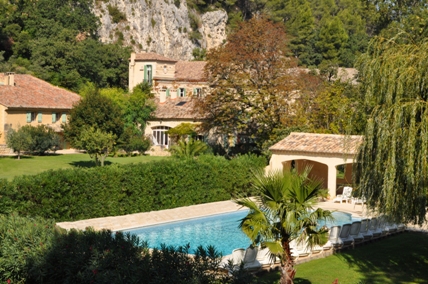The history of the La Roque
The first date that it appears that there was a mill on the grounds of La Roque was in 1454. It seems that it began as a textile mill. However, it wasn't until 1564 that the archbishop of Avignon, lord of Noves, officially conceded this ground for a textile mill so perhaps it had been destroyed and was rebuilt at that time.
In the early 17th century, a large project of drainage of 1700 acres of marshes, covering part of Noves to Saint-Remy, was undertaken. The river Anguillon, as it exists today, was created in order to drain all these waters. The mill was destroyed again during this period to accommodate this project.
The Roux family and the flour mill
In 1682, Antoine Roux purchased the grounds of la Roque, which remained in the hands of his family for approximately three centuries. Following the French revolution, his grandson received the rights to build a flour mill. This mill was completed in 1793.
In the early stages, the mill encountered difficulties as the flow of this river was irregular. At that time other small artisanal activities were created such as tile works, a chalk furnace and a barn for animals.
In 1858, a stone damn was built on the Anguillon river. This damn allowed the mill to operate year round. Six full time millers were employed. During this period, the small artisanal activities were stopped, the large vertical water wheel was replaced by a turbine and the grinding millstones were replaced by cylindrical grinders. At the beginning of the 20th century, the flour mill (including 4 grinders) was producing up to eight tons of flour a day.
The main house of the owner was rebuilt in 1910 in the style of grandeur such that one finds in the city. Inside, the decor followed the period of Art Nouveau, a style very in vogue at that time.
After World War II, the activity of the mill started to decline and it subsequently ceased to operate in 1962. From this period until 1977, the mill produced electricity for the area. In 1977, this activity also stopped as the stone damn on the river was destroyed to avoid flooding which left no water power for the mill to operate.
After the death of Stanislas Roux, the family sold La Roque in 1984.
ref. Lucien Bravelet - Memori de Casteu-Reinard
Restauration of the domain
Baron Fallon, admirer of this domain and its old buildings,, bought La Roque in 1994 and begain his long restoration process.
He has preserved just about all the equipment of the old mill and, as our guest, you are invited to visit them. Baron Fallon will give you a tour and explain the history, how the flour was produced and how the other buildings on the property were used..
Chalk furnace and Tileworks. |

